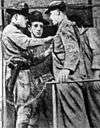Memorial Day massacre of 1937
| Memorial Day massacre of 1937 | |||
|---|---|---|---|
| Part of Little Steel strike | |||
 Photograph from the Committee Papers of the Senate Subcommittee Investigating Free Speech and Labor, titled "The Chicago Memorial Day Incident". | |||
| Date | May 30, 1937 | ||
| Location |
Chicago, Illinois, United States 41°40′58″N 87°32′24″W / 41.682895°N 87.539912°WCoordinates: 41°40′58″N 87°32′24″W / 41.682895°N 87.539912°W | ||
| Parties to the civil conflict | |||
|
| |||
| Lead figures | |||
|
| |||
| Casualties | |||
| |||
In the Memorial Day massacre of 1937, the Chicago Police Department shot and killed ten unarmed demonstrators in Chicago, on May 30, 1937. The incident took place during the Little Steel strike in the United States.
Background
The incident arose after U.S. Steel signed a union contract but smaller steel manufacturers (called 'Little Steel'), including Republic Steel, refused to do so. In protest, the Steel Workers Organizing Committee (SWOC) of the Congress of Industrial Organizations (CIO) called a strike.
Incident
On Memorial Day, hundreds of sympathizers gathered at Sam's Place, headquarters of the SWOC. As the crowd marched across the prairie towards the Republic Steel mill, a line of Chicago policemen blocked their path. The foremost protestors argued their right to continue.[1] The police, feeling threatened, fired on the crowd. As the crowd fled, police bullets killed ten people and injured 30. Nine people were permanently disabled and another 28 had serious head injuries from police clubbing.
Legacy
Years later, one of the protesters, Mollie West, recalled a policeman yelling to her that day, "Get off the field or I'll put a bullet in your back." No policemen were ever prosecuted.
A Coroner's Jury declared the killings to be "justifiable homicide". The press often called it a labor or red riot. President Roosevelt responded to a union plea, "The majority of people are saying just one thing, ′A plague on both your houses′"[2]
Today, on the site of Sam's Place stands the union hall of the United Steelworkers and a memorial to the 10 people who died in 1937.
In the book Selected Writings by Dorothy Day (who was present), the events of the protest are summarized as thus: 'On Memorial Day, May 30, 1937, police opened fire on a parade of striking steel workers and their families at the gate of the Republic Steel Company, in South Chicago. Fifty people were shot, of whom 10 later died; 100 others were beaten with clubs.'
In the wake of the massacre, the news reel of the event was suppressed for fear of creating, in the words of an official at Paramount News agency, "mass hysteria." This footage demonstrated that the massacre was a police riot.[3]
See also
Notes
- ↑ The American Century, Harold Evans, Jonathan Cape, London, 1998 p. 278
- ↑ The American Century, Harold Evans, Jonathan Cape, London, 1998 p. 279
- ↑ "Attack on Pickets by Chicago Police Reported in Film". Christian Science Monitor. 17 June 1937.
References
- Auerbach, Jerold S. Labor and Liberty: The La Follette Committee and the New Deal. Indianapolis: Bobbs-Merrill Co., 1966.
- Baughman, James L. "Classes and Company Towns: Legends of the 1937 Little Steel Strike." Ohio History. 87:2 (Spring 1978).
- Bernstein, Irving. The Turbulent Years: A History of the American Worker, 1933-1941. Paperback edition. Boston: Houghton-Mifflin Co., 1970. ISBN 0-395-11778-X (Originally published 1969.)
- Blake, Benjamin. "Ohio's Steel Mill War The Little Steel Strike of 1937." Crooked River. December 2001.
- Brooks, Robert R. As Steel Goes... Unionism in a Basic Industry. New Haven: Yale University Press, 1940.
- Dennis, Michael J., "Chicago and the Little Steel Strike," Labor History 53 (Spring 2012): 167-204.
- Dennis, Michael J. The Memorial Day Massacre and The Movement for Industrial Democracy. New York: Palgrave MacMillan, 2010.
- Pursuant to S. Res. 266 (74th Congress). A Resolution to Investigate Violations of the Right of Free Speech and Assembly and Interference with the Right of Labor to Organize and Bargain Collectively. Part 14: The Chicago Memorial Day Incident. Hearings Before a Subcommittee of the Committee on Education and Labor. United States Senate. Seventy-Fifth Congress, First Session. June 30, July 1 and 2, 1937. Washington, D.C.: United States Government Printing Office, 1937.
- Sofchalk, Donald G. "The Chicago Memorial Day Massacre: An Episode of Mass Action." Labor History. Winter 1965.
- Speer, Michael. "The 'Little Steel' Strike: Conflict for Control." Ohio History. Autumn 1969.
- Stolberg, Benjamin. "Big Steel, Little Steel, and C.I.O." The Nation. July 31, 1937.
- White, Ahmed. The Last Great Strike: Little Steel, the CIO, and the Struggle for Labor Rights in New Deal America. University of California Press, 2016, pp. 130-146.
